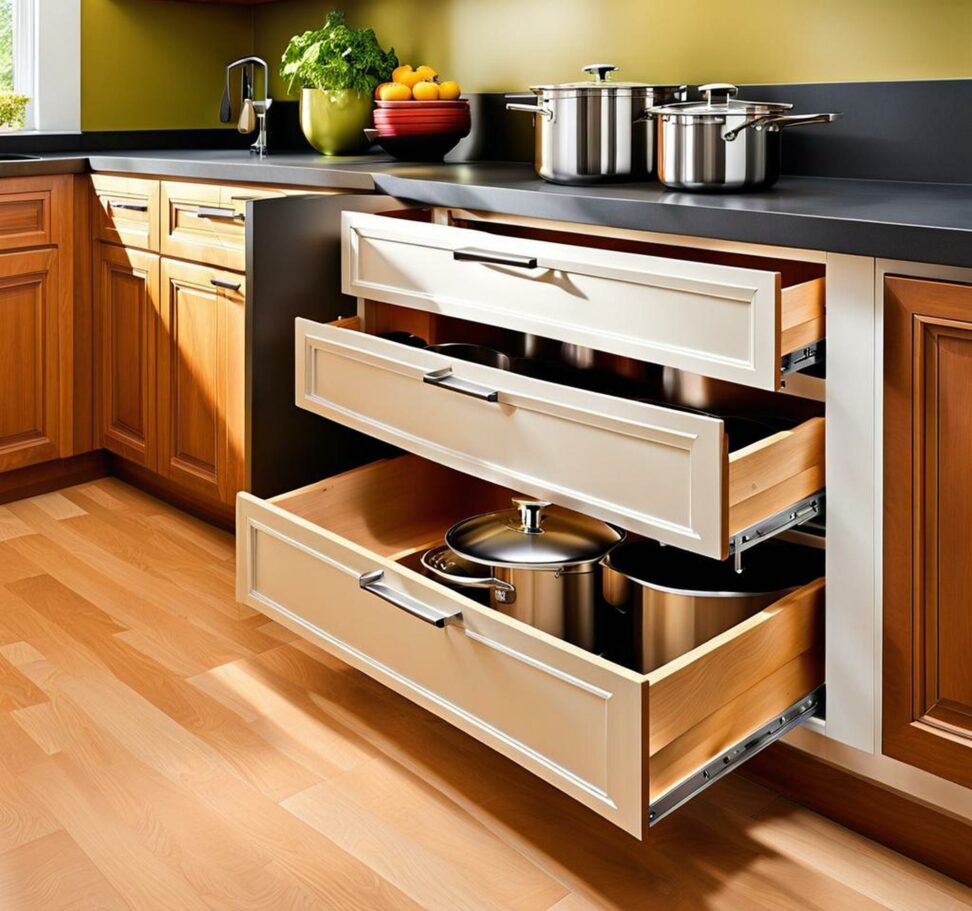The Complete Guide to Adding a Pots and Pans Drawer Base Cabinet to Your Kitchen
Installing a pots and pans drawer base cabinet can revolutionize storage and organization in your kitchen. This smart solution provides specialized spaces to neatly arrange cookware and maximize your existing layout. With some planning and expert installation, you can integrate drawer cabinetry that seamlessly fits your decor and cooking needs.
You'll learn how to determine the right size and placement, choose materials and finishes, organize interiors, and blend the style into your current kitchen. We'll also cover costs, pros and cons, and alternatives to help you make the best decision for your home.

Choosing the Right Size Pots and Pans Drawer Cabinet
Selecting the proper cabinet size is crucial for functionality. Measure available space in your existing kitchen to find spots where drawer cabinets could fit, like along the back wall or island. Standard widths are 36 or 42 inches. Write down the maximum dimensions for each potential spot.
Then take stock of your current pots, pans, lids, and other cookware to understand what you need to store. Measure diameters and depths and note your largest pieces. Compare to standard drawer depths of 20-24 inches to find the ideal height. Opt for the biggest single drawer your space allows to hold large stockpots.
For many homeowners, a 2 or 3 drawer configuration provides sufficient storage, with at least one deep bottom drawer for bulky items. But choose the number of drawers based on your unique collection. More shallow drawers maximize accessibility for everyday pots and pans.
Placement in the Kitchen
The optimal cabinet location depends on your kitchen layout and workflow. Along the back wall or tucked by the fridge is popular to keep bulky cookware out of the way. Kitchen islands allow easy access from all directions.
Focus on choosing a spot that won’t disrupt traffic flow while cooking and minimizes reaching or bending. Also consider the surrounding cabinetry and appliances for a cohesive look. An experienced kitchen designer can help you identify the ideal position.
Installation and Integration
Proper installation is crucial to blend your new pots and pans cabinetry with existing components. Hire experienced kitchen contractors familiar with integrating drawer cabinetry into current cabinetry.
First they’ll remove old cabinets from the spot and prepare the flooring if needed. Next is securely attaching the new cabinets with screws into wall studs and leveling for stability. Side panels will conceal edges for a seamless look.
Use matching cabinet finishes and hardware like knobs or pulls to tie the style together beautifully. Custom coloring or finishes can further integrate the design.
Features and Materials
Pots and pans drawer cabinets come in a variety of durable materials to suit your kitchen esthetic and needs:
- Wood - Attractive but requires sealing from moisture. Oak and maple are popular choices.
- Laminate - Resists stains and dampness but prone to chipping.
- Metal - Very durable but susceptible to dents and showing fingerprints.
Soft-close drawer slides prevent slamming. Fully extending slides make accessing contents easier. Storage accessories like cutlery trays and pan dividers optimize organization. Carefully select finishes and hardware that match your kitchen decor.
Organizing Cookware in the Drawers
Maximize usefulness by strategically organizing your cookware in the deep drawers:
- Group like items together - pans, lids, pots, baking sheets etc.
- Use dividers to separate types and prevent sliding around.
- Keep everyday items handy in top drawers.
- Label contents for easy identification.
A little regular maintenance helps sustain an orderly system. Take a few minutes periodically to reorganize and remove lesser used items from prime real estate.
Costs and Budgeting
A pots and pans drawer base cabinet ranges $250-$1000 depending on size, materials, and custom upgrades. Measure carefully to prevent costly returns or replacements.
Factor in installation costs around $200-500 to integrate seamlessly into existing cabinetry. The investment maximizes kitchen storage and organization for years to come.
Addressing Concerns
Drawer cabinets simplify accessing cookware, but concerns can arise:
- Tight fits making drawers hard to open. A contractor can adjust slides and alignments.
- Clutter accumulating over time. Revisit organization schemes to better suit evolving needs.
- Damage like cracks or dents. Many components can be replaced cost effectively.
Don't hesitate to contact kitchen specialists for adjustments or repairs to get the most out of your customized pots and pans storage system.
Alternatives to Drawer Cabinetry
While drawer cabinets maximize kitchen storage, other options exist:
- Pull-out shelves offer access but with less compartmentalization.
- Vertical racks hang cookware while preserving floor space.
- Wall-mounted rails keep items off counters.
Evaluate whether your cookware collection would function better with these other approaches. But for most homeowners, the specialized storage of drawer cabinets is ideal for pots and pans.
Adding a pots and pans drawer base cabinet is a smart upgrade to boost kitchen organization and storage. Correct sizing and placement optimized for your cookware collection and layout are crucial first steps. Professional installation ensures seamless integration with existing cabinetry for a unified look. Handy drawer access and customizable organization transforms chaotic cookware into a source of pride.
With some planning and expert execution, you can install specialized drawer cabinetry to maximize your kitchen's potential. Just be sure to address any issues quickly to keep your pots and pans storage system in tip top shape for years of cooking joy!